Volete creare una pagina separata per i post del blog in WordPress?
Per impostazione predefinita, WordPress visualizza i post del blog nella home page. Tuttavia, se state creando un sito web aziendale o semplicemente volete personalizzare la vostra homepage, potreste volere una pagina separata per la sezione blog.
In questo articolo vi mostreremo due modi per creare una pagina separata per i post del blog in WordPress.
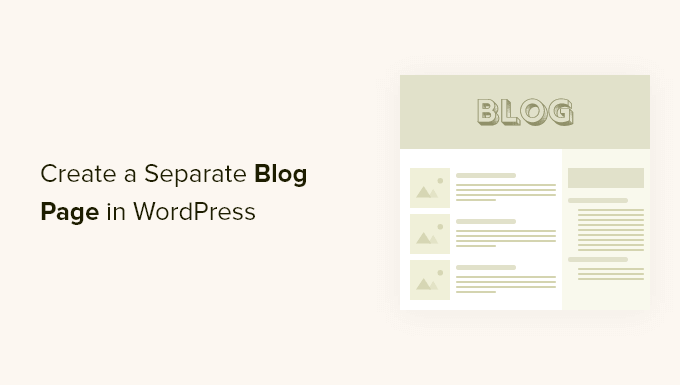
Perché visualizzare i post del blog in una pagina separata?
La home page è la pagina principale del vostro sito web WordPress e la prima pagina che i visitatori vedono. Per impostazione predefinita, WordPress mostra i post più recenti sulla home page, e questo ha senso se gestite un blog.
Ma non è sempre l’ideale per i siti web delle piccole imprese. Probabilmente vorrete una home page più accattivante, che illustri agli utenti la vostra attività, i vostri prodotti e servizi, consenta loro di sapere come contattarvi e aumenti la conversione delle vendite.
Ora, se volete gestire anche un blog sul vostro sito web, dovrete fornire un’altra pagina in cui i visitatori possano leggere i vostri post.
Detto questo, vi mostreremo come creare facilmente una pagina separata per i post del blog in WordPress.
In questa esercitazione abbiamo discusso due metodi e potete usare i link sottostanti per passare al metodo che preferite. Tenete presente che il secondo metodo è il più semplice e offre la massima personalizzazione:
Video tutorial
Se preferite le istruzioni scritte, continuate a leggere.
Metodo 1: Creare pagine separate per i post del blog in WordPress
È possibile creare una pagina separata per i post del blog utilizzando le impostazioni predefinite di WordPress.
Tuttavia, questo metodo richiede un po’ più di lavoro rispetto al metodo 2 e non offre altrettante opzioni di personalizzazione.
Creazione di una pagina iniziale e di una pagina del blog separate
Per prima cosa, è necessario creare due pagine separate in WordPress da utilizzare come pagina iniziale e pagina del blog.
Non è necessario aggiungere alcun contenuto a queste pagine e si può dare loro il nome che si preferisce. Ad esempio, alcuni siti web aziendali utilizzano “News” per la loro pagina blog.
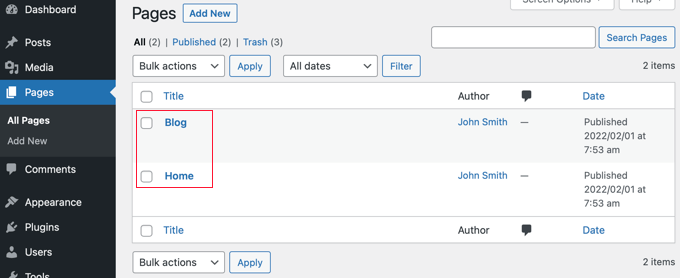
Una volta create queste pagine, visitate la pagina Impostazioni ” Lettura nell’area di amministrazione di WordPress.
A questo punto, nella sezione “Visualizza la tua homepage”, è necessario fare clic sul pulsante “Una pagina statica”.
Successivamente, è possibile selezionare le pagine Home e Blog create in precedenza. Scorrere verso il basso e fare clic sul pulsante “Salva modifiche”.

Ora, quando si accede alla schermata Pagine ” Tutte le pagine dalla dashboard di WordPress, si vedrà che la pagina Home è etichettata come ‘Prima pagina’ e la pagina Blog come ‘Pagina dei post’.
Fare clic sul link “Visualizza” sotto la pagina del blog per visualizzare l’anteprima.
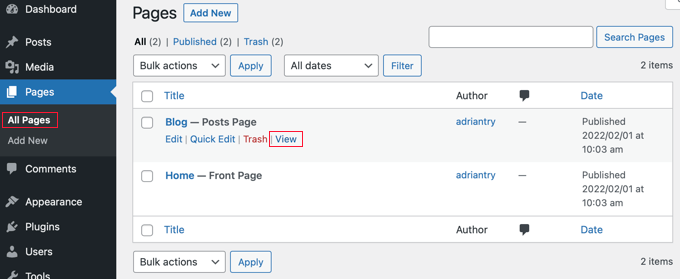
L’aspetto di queste pagine dipende dal tema di WordPress e si consiglia di configurare queste impostazioni.
Ad esempio, se il vostro tema ha un menu di navigazione, noterete che WordPress ha aggiunto automaticamente le nuove pagine Blog e Home. In caso contrario, consultate la nostra guida per principianti su come aggiungere un menu di navigazione in WordPress.
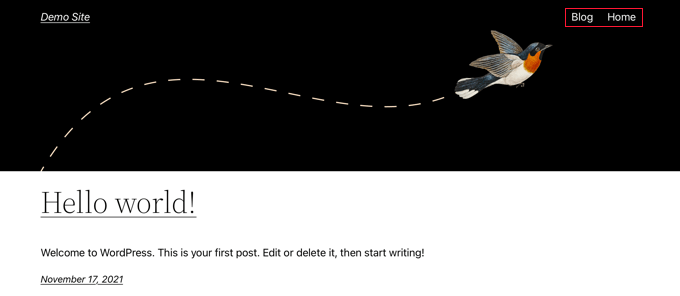
Personalizzazione della pagina iniziale
Finora la vostra nuova home page è vuota. Ora è il momento di aggiungere informazioni sulla vostra attività, sui prodotti e sui servizi e di far sapere ai visitatori come possono contattarvi.
Potete imparare a farlo nella nostra guida su come creare una home page personalizzata in WordPress. Nel Metodo 1, vi mostriamo come utilizzare l’editor di blocchi per aggiungere immagini di copertina, colonne, tabelle, testo e media, gallerie e altro ancora.
Troverete anche molte idee di personalizzazione creativa nella nostra guida su come modificare una home page di WordPress in modo semplice ed efficace.
Personalizzazione della pagina del blog
Se siete soddisfatti dell’aspetto della pagina del vostro blog, il vostro lavoro è finito.
Tuttavia, se attualmente si utilizza un tema a blocchi, è possibile personalizzare la pagina del blog visitando la schermata Aspetto ” Editor dalla dashboard di WordPress.
Una volta arrivati, selezionare l’opzione “Pagine” dalla colonna di sinistra nell’editor completo del sito.
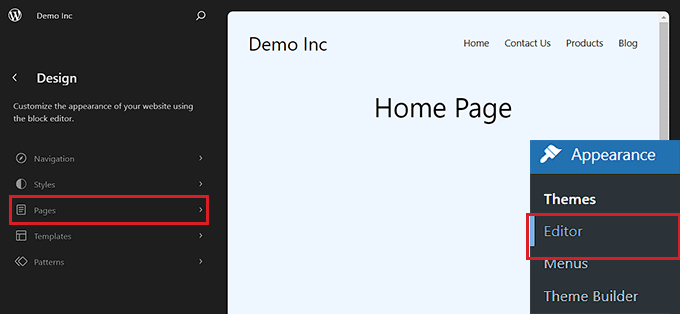
Si aprirà un elenco di tutte le pagine del vostro sito web nella colonna di sinistra.
Da qui, selezionare l’opzione della pagina ‘Blog’ e poi fare clic sull’anteprima della pagina a destra per iniziare a personalizzare la pagina del blog.
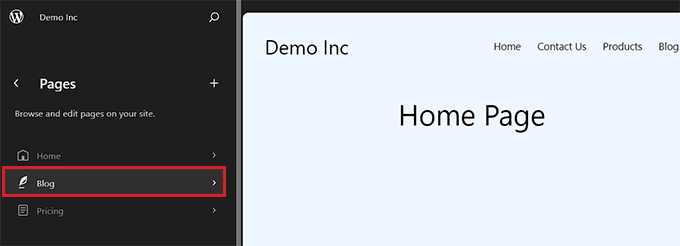
A questo punto è possibile fare clic sul pulsante “+” nell’angolo in alto a sinistra dello schermo e aggiungere alla pagina i blocchi desiderati.
Inoltre, è possibile modificare il colore dello sfondo, del testo o dei link della pagina del blog facendo clic sull’icona “Stili” nell’angolo in alto a destra dello schermo.
Si aprirà un pannello di blocco sulla destra da cui si può fare clic sulla scheda “Tipografia” per cambiare il colore del testo, sulla scheda “Colori” per cambiare il colore dello sfondo e sulla scheda “Layout” per configurare le dimensioni della pagina del blog.
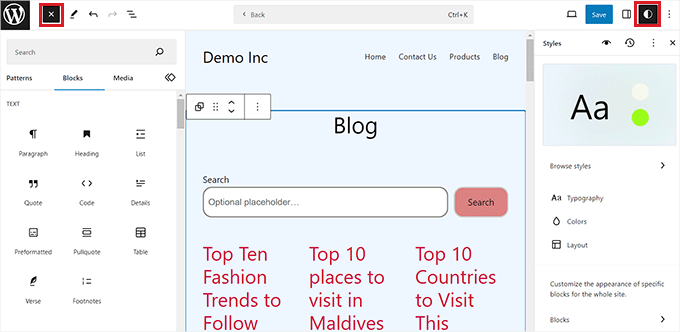
Una volta terminato, non dimenticate di fare clic sul pulsante “Salva” in alto per memorizzare le impostazioni.
Ora è possibile visitare la pagina del blog WordPress per vedere come appare.
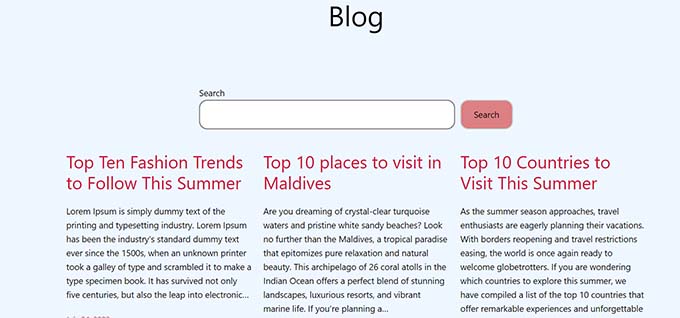
Tuttavia, se si utilizza un tema classico, è necessario utilizzare il metodo 2 per personalizzare la pagina dei post del blog.
Metodo 2: Creare una pagina personalizzata per i post del blog con un costruttore drag & drop (consigliato)
Un plugin per la creazione di temi consente di creare facilmente un tema WordPress personalizzato senza alcun codice. Questo include la possibilità di creare e personalizzare una pagina separata per i post del blog.
Installazione del costruttore di temi SeedProd
Per prima cosa, è necessario installare e attivare il plugin SeedProd. Per maggiori dettagli, consultate la nostra guida passo passo su come installare un plugin di WordPress.
SeedProd è il miglior costruttore di pagine WordPress drag-and-drop per aziende, blogger e proprietari di siti web. Dispone anche di un designer di temi che consente di personalizzare facilmente la pagina del blog e molto altro ancora.
Per maggiori dettagli, potete leggere la nostra recensione completa di SeedProd.
Dopo l’attivazione, visitare la pagina SeedProd ” Impostazioni per inserire la chiave di licenza. Queste informazioni sono disponibili nel proprio account sul sito web di SeedProd.

Dopodiché, è il momento di creare un tema WordPress personalizzato. È molto più semplice di quanto sembri.
Creare un tema WordPress personalizzato
Per prima cosa, è necessario visitare la pagina SeedProd ” Theme Builder. Qui si utilizzerà uno dei temi già pronti di SeedProd come punto di partenza. In questo modo si sostituirà il tema WordPress esistente con un nuovo design personalizzato.
È possibile farlo facendo clic sul pulsante “Temi”.
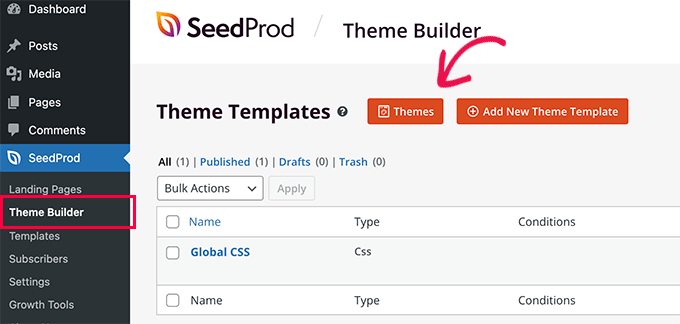
A questo punto vi verrà mostrato un elenco di temi professionali progettati per diversi tipi di siti web.
Ad esempio, esistono modelli chiamati “Modern Business”, “Marketing Agency” e “Mortgage Broker Theme”.
Date un’occhiata alle opzioni e selezionate quella più adatta alle vostre esigenze facendo clic sull’icona del segno di spunta.
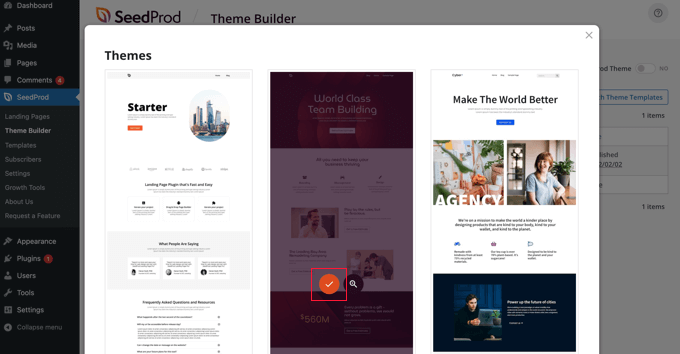
Una volta scelto il tema, SeedProd genererà tutti i modelli di tema, tra cui uno per l’indice del blog e uno per la pagina iniziale.
Non si tratta di pagine vuote, ma di layout accattivanti e di contenuti segnaposto facili da personalizzare.
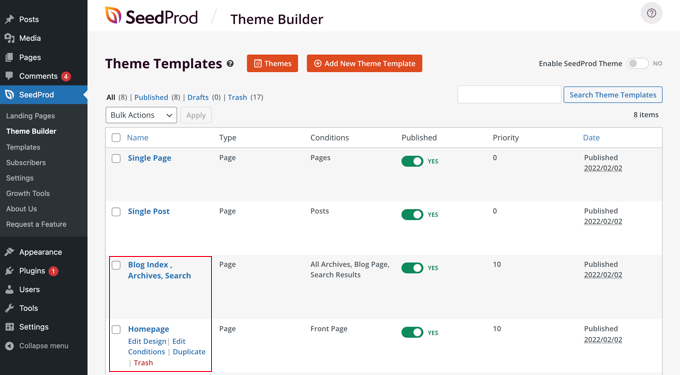
In questo tutorial vi mostreremo come personalizzare i modelli della home page e dell’indice del blog.
Potreste anche voler personalizzare gli altri modelli. Per sapere come fare, consultate la nostra guida per principianti su come creare facilmente un tema WordPress personalizzato.
Personalizzazione della pagina iniziale
Una volta generati i modelli del tema, è possibile modificarli utilizzando il costruttore di temi SeedProd. Inizieremo con il modello Homepage.
Per iniziare, è sufficiente fare clic sul link “Modifica design” sotto la homepage.

In questo modo si avvia il file del modello nel costruttore di temi SeedProd.
Questo semplice costruttore drag-and-drop mostra un’anteprima live della pagina a destra e una barra degli strumenti di blocco a sinistra.
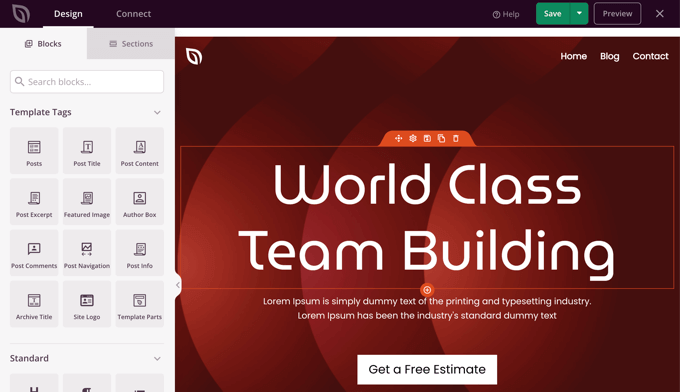
È possibile personalizzare qualsiasi blocco facendo clic su di esso, trascinando i blocchi in alto e in basso con il mouse e aggiungendo nuovi blocchi alla pagina.
Abbiamo scritto una guida completa su come creare una home page personalizzata in WordPress. Basta scorrere fino al Metodo 2 per imparare a personalizzare la vostra home page utilizzando SeedProd.
Personalizzazione della pagina del blog
Il costruttore del tema SeedProd offre anche molte possibilità di personalizzare la pagina di indice del blog.
Per iniziare, fate clic sul link “Modifica design” sotto la pagina.

Vedrete lo stesso riquadro di anteprima sulla destra e la barra degli strumenti sulla sinistra. È possibile personalizzare la pagina del blog nello stesso modo in cui si è fatto con la pagina iniziale.
Ad esempio, facendo clic sul titolo, è possibile visualizzare tutte le sue impostazioni. È possibile modificare il testo, cambiare l’allineamento e la dimensione dei caratteri e altro ancora.
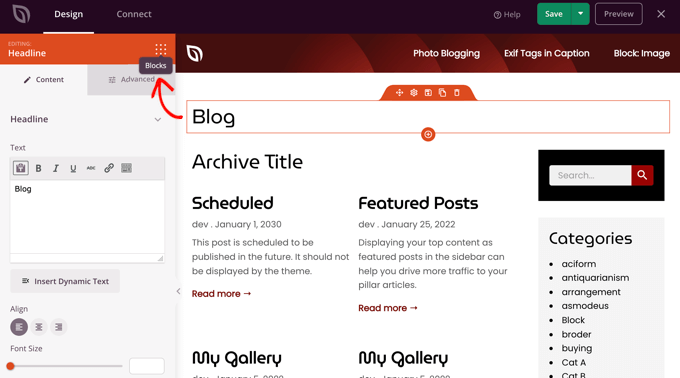
Una volta terminato, è necessario fare clic sull’icona ‘Blocchi’ per tornare alla barra degli strumenti.
Il costruttore del tema SeedProd offre ulteriori blocchi Template Parts, come il blocco Posts, che visualizza un elenco dei post del blog.
Il blocco Messaggi è già stato aggiunto al modello dell’indice del blog; in questo modello, il blocco visualizza i messaggi in due colonne. Possiamo cambiarlo in una singola colonna.
È sufficiente fare clic sul blocco Messaggi e modificare l’impostazione ‘Colonne’ in 1.
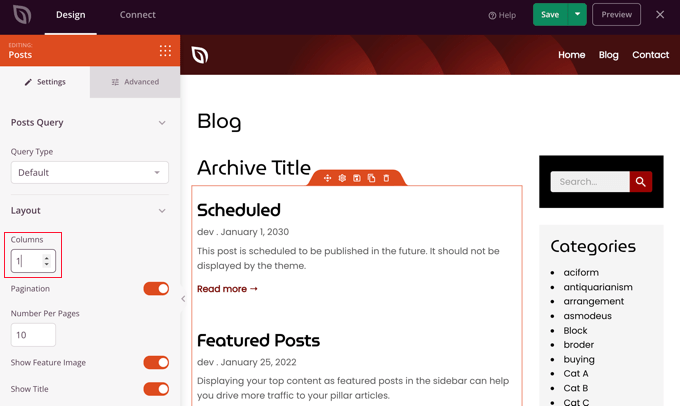
Il layout cambierà immediatamente in una singola colonna.
Scorrendo le impostazioni del blocco Messaggi, si trovano dei selettori che consentono di scegliere se visualizzare o meno l’immagine caratteristica e il titolo del post. Si può anche scegliere quale tag di intestazione utilizzare per il titolo del post.
Sono disponibili anche opzioni per la visualizzazione di diversi metadati dei post. È possibile modificare la data di modifica, l’autore, la data e l’ora di pubblicazione e il numero di commenti.
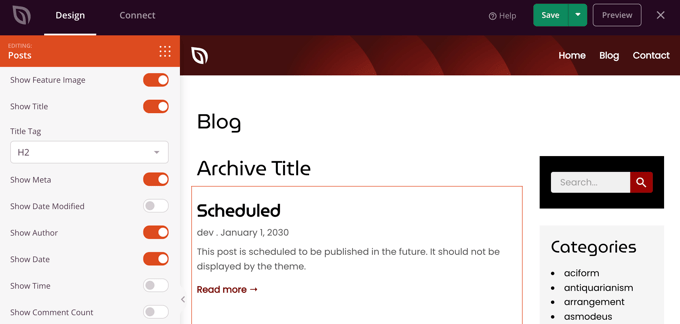
Ecco altri modi per personalizzare l’indice del blog:
- È possibile filtrare l’indice per tipo di post, categoria, tag o autore.
- L’ordine dei messaggi può essere modificato.
- È possibile scegliere quanti post visualizzare in una pagina.
- È possibile attivare l’estratto del post e personalizzarne la lunghezza.
Una volta terminata la personalizzazione della pagina del blog, assicurarsi di fare clic sul pulsante “Salva” nella parte superiore della schermata. Quindi, è possibile tornare all’elenco dei modelli facendo clic sull’icona “X”.
Abilitazione del tema SeedProd
Una volta terminata la personalizzazione dei modelli di tema, è necessario pubblicare il nuovo tema personalizzato.
È sufficiente spostare l’impostazione “Abilita tema SeedProd” su “SÌ”.
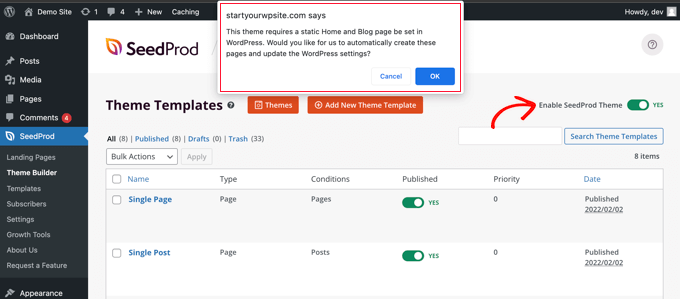
Verrà immediatamente visualizzata una notifica che indica la necessità di modificare le impostazioni delle pagine Home e Blog di WordPress. Facendo clic sul pulsante “OK”, queste impostazioni verranno modificate.
Ora è possibile visitare il sito web per visualizzare la nuova home page e la pagina del blog. Ecco come appare la pagina indice del blog sul nostro sito demo.
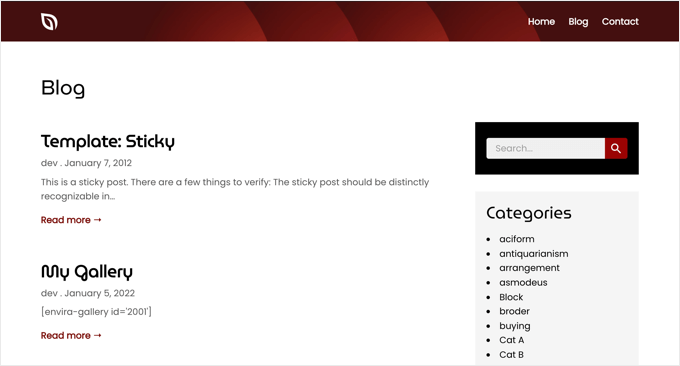
Bonus: visualizzare i post recenti in WordPress
Una volta creata una pagina blog separata, potete comunque mostrare alcuni post recenti nella vostra home page per incoraggiare gli utenti a esplorare meglio il vostro sito.
Per farlo, aprire la propria homepage nell’editor di blocchi di WordPress. Una volta lì, fate clic sul pulsante “Aggiungi blocco” nell’angolo in alto a sinistra dello schermo per aprire il menu dei blocchi.
Da qui, è sufficiente aggiungere il blocco “Ultimi messaggi” alla pagina. Una volta fatto ciò, è possibile personalizzare l’elenco dei post recenti per visualizzare gli estratti dei post, i nomi degli autori e le date secondo le proprie preferenze.
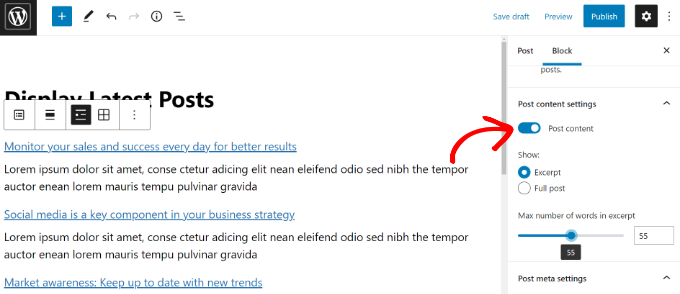
Infine, fare clic sul pulsante “Pubblica” in alto per salvare le impostazioni. Ora, alcuni dei vostri post recenti saranno ancora visualizzati nella home page per garantire che gli utenti trascorrano più tempo sul vostro sito web.
Per maggiori informazioni, potete consultare il nostro tutorial su come visualizzare i post recenti in WordPress.
Speriamo che questo tutorial vi abbia aiutato a imparare come creare una pagina separata per i post del blog in WordPress. Potreste anche voler imparare a scegliere il miglior hosting per WordPress o dare un’occhiata alla nostra lista dei migliori software di live chat per le piccole imprese.
Se questo articolo vi è piaciuto, iscrivetevi al nostro canale YouTube per le esercitazioni video su WordPress. Potete trovarci anche su Twitter e Facebook.





Syed Balkhi says
Hey WPBeginner readers,
Did you know you can win exciting prizes by commenting on WPBeginner?
Every month, our top blog commenters will win HUGE rewards, including premium WordPress plugin licenses and cash prizes.
You can get more details about the contest from here.
Start sharing your thoughts below to stand a chance to win!
Ismet Fitri says
I would love if wpbeginner would share how you design your archive page. It looks so cool! Seeking for some help from your awesome team!
WPBeginner Support says
For the moment we use our theme which is custom designed but for easy ways to customize your theme you can take a look at page builders like the ones we list in our article below!
https://www.wpbeginner.com/beginners-guide/best-drag-and-drop-page-builders-for-wordpress/
Admin
Steven Baldwin says
Followed your instructions for creating static homepage and blog posts. However, when I made the changes in the settings>reading I forgot to click on homepage. Hence, no static homepage, can I correct this so I have a separate page from my blogs.
Thank you
WPBeginner Support says
If we understand the question correctly, you should be able to go back into your settings and set your static home page so your blog posts are on a separate page.
Admin
John says
Hi, what if i have multiple archive post pages? but wordpress only has 1 post page to assign. Which one do i assign? or shall i leave it blank?
WPBeginner Support says
Your posts archive page would list every post on your site. If you wanted to separate by category, you can add links to the category in your menu and WordPress will generate an archive page for that category.
Admin
Tracey says
Struggled to combine static pages and a blog. Couldn’t find a clear how to – until now. Finally fixed it. Thanks!
WPBeginner Support says
Glad our guide could help
Admin
Gwyneth Llewelyn says
Much, much easier than I thought. Thank you so much!
WPBeginner Support says
Glad our guide was helpful
Admin
Mirta says
Nice guide and thanks for help!
Now I managed my blog as I wanted to!
WPBeginner Support says
Glad our guide was helpful
Admin
Bernice says
My WordPress site is not displaying my blog posts on the blog page… Even after I set the blog page to post page… Please help..
WPBeginner Support says
The most common reasons would be you would either need to clear your caching or check with your specific theme’s support to see if there is a theme-specific setting hiding the posts.
Admin
Ron Gladden says
Much appreciated, I wasn’t asking google the right question but finally, I found your blog and solved my problem in 1 minute that I was working on for 2 hours. Thanks!
WPBeginner Support says
Glad our guide could help
Admin
Chris says
THANK YOU! Somehow my blog page stopped populating posts and I found that all I had to do was update my Reading settings to make my blog page my posts page. Thanks!
WPBeginner Support says
Glad our guide was helpful
Admin
Sandi says
Thanks it’s very helpful. But can you make the post slug following the blog?
for example.my blog post will be example.com/blog
can we make the new post and show the slug like this “example.com/blog/new-post” instead of “example.com/new-post” ?
WPBeginner Support says
You would set that up in your permalinks which we cover in our guide below:
https://www.wpbeginner.com/wp-tutorials/how-to-create-custom-permalinks-in-wordpress/
Admin
Odysseas says
Hi, I want my subdomain which is a blog to be added to the bottom menu.
WPBeginner Support says
To do that you would want to create a custom menu and add that as a menu widget for what it sounds like you’re wanting to do.
Admin
Sheetal Pawar says
if i am Posting 10 blogs per page then how can i distinguish between 2 post i mean how can i add the border so that the user will understand where the 2nd post starts
WPBeginner Support says
Your theme’s styling should style the title of the post and some themes add separators for you.
Admin
Rachelle Partee says
Hello!! How do you have different posts on different pages? For example I would like to have the blog page and a photography page with different posts.
WPBeginner Support says
You could either use category pages like we do to separate our posts:
https://www.wpbeginner.com/beginners-guide/how-to-add-navigation-menu-in-wordpress-beginners-guide/
Another option would be to create a custom post type for your photography:
https://www.wpbeginner.com/wp-tutorials/how-to-create-custom-post-types-in-wordpress/
Admin
Chip says
I am building a site in which I would like blog posts to go to one page, and podcasts go to another page.
Is that possible?
Thanks.
WPBeginner Support says
You could create categories and add those categories to your menu which would add posts from those specific categories to those pages. Another more complex option would be to create a custom post type for your podcasts:
https://www.wpbeginner.com/wp-tutorials/how-to-create-custom-post-types-in-wordpress/
Admin
Tracey M Edwards says
I have my Blog set as a Blog page. I’m having difficulty with the padding around the graphic for my Blog. When I move the slider on Blog Title Style, nothing changes around the graphic.
Thank you!
Tracey
WPBeginner Support says
For the styling of your site, we would first recommend reaching out to the support for your specific theme to see if they have a built-in option for what you’re wanting or if it is a hiccup with the theme itself.
Admin
Liton Biswas says
I followed all the steps. I created two pages. One is for home and another is for blog.
After that I went to setting > reading and set those pages properly. My home page is showing properly but the post page isn’t show my posts.
WPBeginner Support says
You would want to ensure your posts are published and you’ve cleared any caching on your site for the most common reasons
Admin
Review Dunk says
I am posting my new blog in my WordPress site but it doesn’t show in the blog site
WPBeginner Support says
If the posts are published then you may want to try clearing your cache as well as the other recommendations in our guide below:
https://www.wpbeginner.com/wp-tutorials/how-to-fix-wordpress-website-not-updating-right-away/
Admin
Taylor Mills says
Is there a way to have the blog posts listed on the home page AND the blog page??
WPBeginner Support says
You could use one of the methods in our article below for what you’re wanting:
https://www.wpbeginner.com/wp-tutorials/how-to-display-recent-posts-in-wordpress
Admin
daniel says
the problem is that when I configure the homepage settings to static homepage some of my built in theme features are not displaying such as my homepage slider which only shows if I configure settings to latest posts.
WPBeginner Support says
You would want to reach out to your theme’s support and they would be able to help with allowing that feature on other pages.
Admin
Ken says
I followed “Put The Blog Page Link to Your Website’s Navigation Menu” . All steps are right . Why i click the “blog” menu ,it comes out blank . But when i preview it on admin panel , it is ok .
WPBeginner Support says
You may want to try clearing all of your caching on your site for the most common reason for that type of issue.
Admin
Nozie says
Thank you so much you helped me in ways I can’t describe after being stuck ffor days. My problem now is that I can’t see an option to view my new Blog page as full width, which is what I’d like to do. It still shows the post plus widgets on the side.
WPBeginner Support says
You would want to check with your theme’s support to see if your theme has a full-width template.
Admin
khalid says
very good but i need to hide the homepage menu when log in to the blog page,how can i do it?
WPBeginner Support says
For what it sounds like you’re wanting, you would want to take a look at our article below:
https://www.wpbeginner.com/plugins/how-to-add-conditional-logic-to-menus-in-wordpress/
Admin
Ann says
Very helpful! Thanks a lot for making it easy for me!
WPBeginner Support says
You’re welcome
Admin
Marwa El-Agroudy says
Thank you so much for this post! It was really really helpful!
WPBeginner Support says
Glad our guide was helpful
Admin
Lloyd Adams says
Thanks very much for sharing your knowledge. I appreciate it.
Cheers.
WPBeginner Support says
You’re welcome, glad you find our guides helpful
Admin
Leng Castillo says
Hello!
I added pages on my website (like FOOD, BEACHES, TRAVEL ABROAD) but I can not transfer my blog posts from HOME (the default setting) to each individual page and make it like HOME too. Please help me with this. Thanks so much.
WPBeginner Support says
You would want to add a category to your menu if you’re wanting all of the posts from a specific category to appear on a page.
Admin
Leng Castillo says
How will I do that?
WPBeginner Support says
You would want to take a look at our article below for the specifics:
https://www.wpbeginner.com/beginners-guide/how-to-add-navigation-menu-in-wordpress-beginners-guide/
Polly says
Hi, I want to customize my blog post index page. I’ve got a different home page so i did the static page thing which worked, but the feature image on the blog index page is enormous and I’d like to reduce it. I don’t know how to reduce it. If I add the beaver builder, will this interfere with the fact I am using the Astra theme?
WPBeginner Support says
Using beaver builder should not cause a problem
Admin
Mohamad Yusli Jamani says
Hi There,
I need your favour & I got something to ask about.
I have a list of Top Menu, with HOME, ABOUT, BLOG (with sub-menus Articles, Listing) and CONTACT menu.
I want to allow my Author to write in to the sub-menus Articles, Listing page, instead of writing into HOME, how can I set it?
Thank you in advanced.
WPBeginner Support says
If you limit the author to posting in that specific category you can then limit that category from appearing on your home page following our guide below:
https://www.wpbeginner.com/plugins/how-to-hide-a-post-from-home-page-in-wordpress/
Admin
Chris says
Hello, I use my Blog posts as my main page currently and don’t have a home page.
Under Pages I have ‘Home’ (inactive), ‘About’ and ‘Contact’.
Is there a way i can create a ‘Blog’ page that will simply link to main page (which is my blog posts). i don’t wish to have a home page
WPBeginner Support says
For what you’re wanting, you would want to modify the title of your link in your menu instead of creating a brand new page
Admin
Yv says
Hi,
I created the blog page as you suggested so that I can create a static page. I like it! However, I don’t know if it’s because of a plugin that I’ve since deleted, or not, but my single blog posts aren’t showing my logo and menu. They show on the static page and on any menu page when I click on it, but they’re missing on the actual single blog posts. My blog’s title is the first thing you see at the top of the page. I need help figuring this out. Do you have any idea why?
WPBeginner Support says
We would recommend first checking the support for your specific theme as there are many different theme designs and yours may not add that for single posts.
Admin
Janet says
Is this applicable if my plan is a personal plan? Because I dont see the option of ‘reading’
WPBeginner Support says
It should still be an option in the settings in your wp-admin area. For the moment our tutorials are for self hosted versions of WordPress and you can see a comparison of the two here:
https://www.wpbeginner.com/beginners-guide/self-hosted-wordpress-org-vs-free-wordpress-com-infograph/
Admin
King Killer says
Thanks for good job!
WPBeginner Support says
You’re welcome
Admin
Susan says
If I have a blog that currently uses the default option of posts going to the front page, and I have three+ years of blog posts, can I still create and publish two pages (HOME and BLOG), select them in the dashboard correctly and have this work as described? Or is it too late if you’ve already gone down the default path?
WPBeginner Support says
Yes, you can change to having a static home page and a blog page at any point in and it would still work
Admin
Zachary says
Is it necessary to select a static page as a blog page in the Reading settings? Will it affect my SEO in any way if I were to leave that blank?
WPBeginner Support says
If you leave it blank then you would not have a page that lists your posts which would affect your SEO if your content is heavily based on posts.
Admin
Stacy says
If I’ve already been posting my blog posts to my home page and want to create a blog page how do I transfer the blog posts over? Will simply creating a new page called “blog” do that automatically?
WPBeginner Support says
No, you would need to set the posts page in your settings for it to list your posts like a blog. If you want the recent posts on a second page, you would want to check with the support for your currently active theme for if that is available.
Admin
yahaya sani says
This is really helpful and educative
WPBeginner Support says
Thank you, glad our article could be helpful
Admin
Sweta says
This is indeed so helpful.
WPBeginner Support says
Glad our guide was helpful
Admin
don hawley says
I Know i am missing something simple. I have a website and have followed the instruction on how to set up a blog page. However the blog page says “Welcome to WordPress. This is your first post. Edit or delete it, then start blogging!” great except that I can’t seem to delete it. What am I doing wrong?
WPBeginner Support says
You’re not doing something wrong, that is the default WordPress post, you should be able to log into your wp-admin area and in the Posts area is where you would delete the post
Admin
Parvathi Reddy says
In my wordpress page to assign a custom template to page there is no template option in page attributes
WPBeginner Support says
You would want to check your options in the editor that the template area is not hidden. If you are in the block editor you would find the option under the three verticle dots in your editor.
Admin
Arnolfo says
Thanks for the tutorial. I’ve set up a blog page for recent blogs but I cannot show the entire blog for the most recent blog. Seems I can only show excerpts and lists of recent blogs which link to their pages. How can I show the entire most recent blog post PLUS the links to previous blogs?
WPBeginner Support says
That would be determined by your theme. If you reach out to your theme’s support they should be able to let you know what customizations are available
Admin
Jessica Dennis says
Help – I followed the instructions in the video but now my new blog page displays my home page! Why would this be happening? I also have Elementor on my site
help!!!!!
WPBeginner Support says
Did you set both to be the same page? Your theme may also have a setting for displaying your posts on your home page so you may want to check with your theme’s support or try swapping themes to see if that resolves the error.
Admin
valentine kalu says
i have Homepage, musics page, Videos page, and so on. how can i post videos post on videos page and post musics on musics page and all the post in music and videos pages will still appear in homepage and also in video and music page.
WPBeginner Support says
For that, rather than creating pages it may be best to use WordPress’ default category pages by adding them to the menu and WordPress will list the posts in that category on the category page. We have an article showing how to add the categories to you menu here:
https://www.wpbeginner.com/beginners-guide/how-to-add-navigation-menu-in-wordpress-beginners-guide/
Admin
Christina says
Hi, i have been spending hours to learn how to add a blog to my exisitng wordpress site but nothing seems to work. A brief of my wordpress site. Our homepage consists of multiple post serving as ‘NEWS’ so not allowing any comments. We now want to add a blog to one of our menu items, anyone can help? Thanks
WPBeginner Support says
If you are already using your posts for a different option than your blog then you would need to use either a subdomain or create a custom post type. You may want to take a look at our article here:
http://wpbeginner.com/wp-tutorials/how-to-create-custom-post-types-in-wordpress/
Admin
Jim Redmond says
Hello WP Beginner,
I built a site a couple of years ago with no intention of ever adding a blog. Now I’d like to add one. Originally I built the home page “latest post” not a “static” page. Retrospectively I can clearly see the error of my ways. Is there an easy method to change things now?
I keep coming back to the conclusion I need to build the blog on a subdomain.
Any help is appreciated.
Thank you, Jim R
WPBeginner Support says
If you want to keep your home page the same while adding a blog page you could use a plugin like the shortcode plugin we recommend in our article here:
https://www.wpbeginner.com/wp-tutorials/how-to-display-recent-posts-in-wordpress/
Admin
Brian H says
I want to ad a blog page displaying 5-10 of our latest posts per page but I don’t want to lose my current home page displaying our latest posts. I’d like to be able to maintain my current categoried formal posts/articles while adding a section of running blog posts. Can I have my cake and eat it too or am o asking too much?
WPBeginner Support says
You would likely want to take a look at the plugin from our article here: https://www.wpbeginner.com/wp-tutorials/how-to-display-recent-posts-in-wordpress/
for what it sounds like you want.
Admin
Ana Ofelia says
Thank you! This was very useful and easy to understand.
WPBeginner Support says
You’re welcome, glad our article could be helpful
Admin
ukasha says
hope you doing well!
is it possible to create separates page for all separate blogs? i create a website like trip adviser know i want that my all blogs related to hotels show on hotel page and blogs related to trip packages show on package pages
and suggest me a good theme for free because this is my starting
WPBeginner Support says
For what it sounds like you’re wanting, you could create category pages to separate your content. You would add the category to your menu to get the url for the category page as we show in our article here: https://www.wpbeginner.com/beginners-guide/how-to-add-navigation-menu-in-wordpress-beginners-guide/
Admin
Nzi says
Totally saved my butt after two hours poking around and not knowing what I had broken. Thanks!
WPBeginner Support says
Glad our guide could help
Admin
Katherine Cannon says
I watched the tutorial and did what it said. Nothing appears when I click the Blog item on my menu. Where can I go for help?
WPBeginner Support says
You would want to ensure the blog item in your menu is linking to the page you set as your posts page, you have posts published, and you cleared your cache for the most common reasons for nothing appearing.
Admin
Kennix says
Hi there, I am new to WP with the free plan.
I cannot find the “Dahsboard>Appearance> Menu> ” and my screen environment is totally different from yours. Is it only available for those paid users?
Thanks, Kennix
WPBeginner Support says
Our tutorials are for WordPress.org sites, you can see the differences here: https://www.wpbeginner.com/beginners-guide/self-hosted-wordpress-org-vs-free-wordpress-com-infograph/
If you wanted a similar look to the admin area on your site then there should be a menu item to go to your wp-admin area
Admin